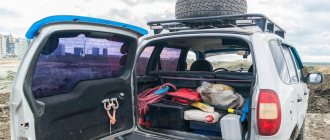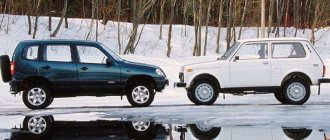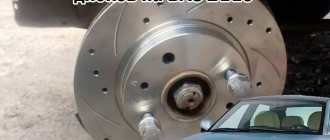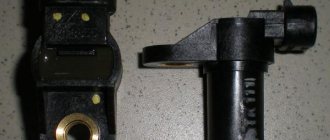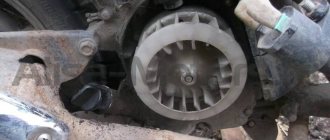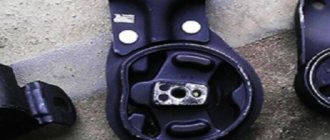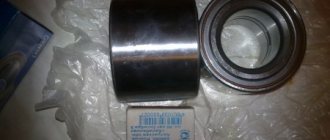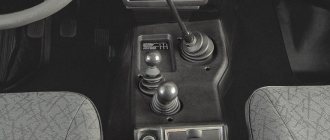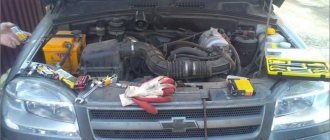About the wheel mounting design
The fact that the wheel nuts are a special product is evidenced by a non-standard metric thread with a diameter of 12 mm with a pitch of 1.25 mm. Standard coils of the same diameter have a different pitch, 1.75 mm. That is, the wheel threads are made smaller in order to increase the reliability of the connection and implement the “self-tightening” effect due to constant rotation. Larger coils will not work here.
The factory nuts are sized so that when the thick stamped steel wheel is tightened, they will fit completely onto the stud. In this case, the element is equipped with a cone at the end, adjacent to the mating part on the disk. Due to the cone-shaped connection, 2 problems are solved:
- self-centering of the hole in the disk opposite the stud when the nuts are evenly tightened;
- more reliable connection of the wheel plane with the hub.
The pin, which carries the load of the entire fastening, is pressed into the hub on splines with an interference fit, and it is sometimes very difficult to knock it out. This is another reason to take the selection of parts for this unit seriously. All nuts available for sale for Niva can be divided into 2 types:
- Open, the pin passes through them when twisted. The car is equipped with such parts at the manufacturer.
- Closed, with a blind hole. Installed on Chevrolet Niva, but the size is also suitable for VAZ-21213.
Factory elements are manufactured with a size for a 19 mm wheel wrench. Various parts found in stores can be made with a 21 mm turnkey, and reach a height of 30 mm or more. The standard length of the open VAZ-2121 nut, made of uncoated carbon steel, is 17 mm. The new decorative parts have a nickel plated finish and a different protruding head shape.
Bolts and nuts for alloy wheels - drive2
To secure the disc to the wheel hub, use special bolts suitable for alloy wheels.
The use of bolts from stamped disks is unacceptable. Depending on the fastening design, nuts for alloy wheels can also be used; nuts from stamped wheels are also not applicable for use with alloy wheels. The thing is that bolts and nuts for alloy wheels have a more developed spherical or conical surface in contact with the disk. This feature of the fastener is a consequence of the softness of the metal from which the cast disk is made and, accordingly, entails an increase in the contact area between the disk and the fastener.
Most alloy wheels are designed to use tapered fasteners (60 degree angle).
For alloy wheels, the thickness of the wheel is greater than that of steel, so longer bolts are used.
It is also worth saying that due to the softness of the metal of the disk, it is necessary to regularly check the tightness of the bolts and nuts, especially on new disks, when the metal in the contact spot of the disk has not yet been strengthened due to the forces of the load on the wheel and fastening the bolts. When choosing bolts and nuts, it is important to purchase exactly the fasteners that fit your drive.
A conical bolt (nut) is a bolt (nut) whose contact area with the mounting hole has a conical shape, and is ideal for fastening alloy wheels.
The nuts for fastening alloy wheels must be selected those that necessarily have the same height and thread as the disk, as well as contact surfaces (nuts for alloy wheels must have special washers that increase the mating area). Also make sure that the cone of the nut coincides with the cone of the hole.
The cylindrical form of fastening (fastening element with a flat press washer) is also used for fastening light-alloy wheels.
Typically, spherical nuts are used to fasten stamped (metal) disks, and conical nuts are used for cast and forged disks (aluminum alloy). Take this into account when installing a spare tire and replacing stamping with casting!
And also interesting: Buy car winches in Saratov. Shop "Trial 4x4"
Tightening bolts and nuts on alloy wheels
Lubricate bolts for alloy wheels and nuts for alloy wheels with graphite grease before installing them in the mounting sockets; this is necessary so that when contact with the disk begins, the head of the bolt or nut has the opportunity to rotate, ensuring a complete fit, and not become stuck due to the initial forces friction between the disc and the fastener.
There are also bolts that compensate for slight deviations in the dimensions of the fasteners on the wheel rim. More details about them in the article “Bolts with a floating cone (eccentrics)”.
Having discs with similar but slightly different PCD dimensions, the situation can be corrected using floating cone bolts. So there are disks with a PCD size of 98 mm, but 100 are needed, or vice versa, which is not important. These two millimeters can be compensated for by a floating cone placed on the bolt. The gap between the inner seat diameter of the cone and the outer diameter of the bolt will provide some movement. Usually this movement is specified when the bolts are sold and is indicated on the packaging as “variation”.
When selecting wheel fasteners, it is especially important to take into account the length of the threaded part of the bolts screwed into the hub, where the number of complete screwed-in turns must be at least six (10mm), the same applies to the nuts. If the number of complete turns is less than six, replace the bolt (stud) with a longer size.
Prepared using materials and articles from the Internet.
Article on the topic: What types of nuts, bolts, studs and wheel locks are there (photo)
Why change the mount?
There are several reasons why Niva car owners change their wheel nuts to new ones:
Old nuts that are worn or mechanically damaged do need to be replaced, especially when they have poor threads or missing edges. It is difficult to tighten such a part with a torque of 10-11 kgf/m to securely fasten the wheel. It’s better to install a new set; it’s pointless to change 1-2 fasteners. The main thing is that the threaded part of the stud remains normal.
Alloy wheels, although thicker than stamped steel ones, can theoretically be fastened with factory nuts. Another thing is that such details will ruin the entire appearance of the new wheels, so in such a situation it is better to install elements that are in harmony with the wheel. There is another point: in some models of alloy wheels, samples are made in the form of a hemisphere, rather than a cone. Then the standard fasteners will definitely not fit; you need to purchase nuts with a spherical end that fit into the mating part of the rim.
Pros and cons of secret fasteners
To prevent your Chevrolet Niva from being “taken off” the next night after installing new tires, it is recommended to install 1 secret nut on each wheel. No matter how new technologies develop, more reliable means of stingray theft have not yet been invented. Hence the first and main advantage of the secret: such fasteners will help protect much more expensive property from thieves than it is worth.
Modern secrets are no match for the first ones that appeared in distant Soviet times. They are structurally more perfect and differ in aesthetics, which is important. The part is an elongated nut with an adapter for an individual key. If you choose closed-type decorative fasteners of the same length for it, then the wheel as a whole will look quite aesthetically pleasing.
The secret mount is very useful for the spare wheel of the Chevrolet Niva, which is screwed to the bracket on the rear door with ordinary nuts, and therefore most vulnerable to thieves. To unscrew secrets, the following types of keys are made:
To prevent the nut from being grabbed by a gas wrench or other similar tools, the lock on top is equipped with a rotating bushing (shell), and the place for the wrench is located in a recess. Cheap products and fakes may not have a shell, so you cannot buy such nuts. The disadvantages of secrets are:
- The tightening torque is weak, so the remaining nuts must be held securely;
- any tricky fastener can be unscrewed if the thief has the time and opportunity to do so;
- the need to always have the key with you and not forget it under any circumstances.
The last drawback is a real scourge of forgetful drivers. If the ramp of exits 2 is punctured: go get the key or call a tow truck, otherwise the wheel cannot be removed.
Changing the wheel
It is necessary to change the wheel in the following cases:
- tire damage;
- disk damage;
- when the tire wears out;
- when upgrading a car.
The replacement process is as follows:
- The Shevik is placed on a hard surface and the handbrake is applied.
Do not forget about supports or shoes, they prevent the raised car from rolling off the jack.
It is also important to tighten the nuts evenly. This will reduce the risk of the wheel skewing and unscrewing spontaneously. The final tightening of the nuts is carried out after removing the jack.
Replacing front and rear wheel studs on a Chevrolet Niva
A stud is the same threaded bolt, only its head is mounted into the car hub. Studs are replaced when they break: the thread is damaged or the design of the part is deformed. In this case, you need to change it to a new one. The procedure for removing and replacing the front wheel product:
- The car is jacked up, then the wheel, brake caliper and disc are removed. Disconnect the hub and disc.
- Using a hammer, knock out the damaged pin from its seat. It will not be possible to knock it out completely, since its head will rest against the shoulder of the rotary cam. To remove it without dismantling the hub, you need to use a file or cut off the head with a grinder. The head is ground off with a file on one side and then protruded through the collar.
- The front wheel stud has been removed. Now we install a new one. Before installation, it is worth grinding off the edge of the stud head in the same way and installing it in the hub hole. You can use a spacer to fix the stud in the flange until it stops.
Methods for securing car wheels
There are two ways to fasten wheels, but they all require the same arrangement of certain fasteners. The first method involves the use of internal threads in the wheel hub. The wheels are suspended on guides and then tightened using bolts that are screwed into the hub.
The second mounting method involves the use of special wheel studs, which eliminate the need for guides for the wheel hub. These studs themselves act as guides and have external threads. Thus, the wheel is secured not with bolts, but with nuts.
The advantage of studs is that, unlike threaded holes, they can be easily replaced. It happens that car service workers tighten the wheel too tightly that the thread in the hole breaks off and then the driver will have to change the entire hub or just the bearing. In the case of studs, they can be replaced if damaged, thereby saving on replacing the hub.


